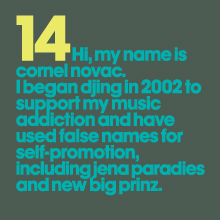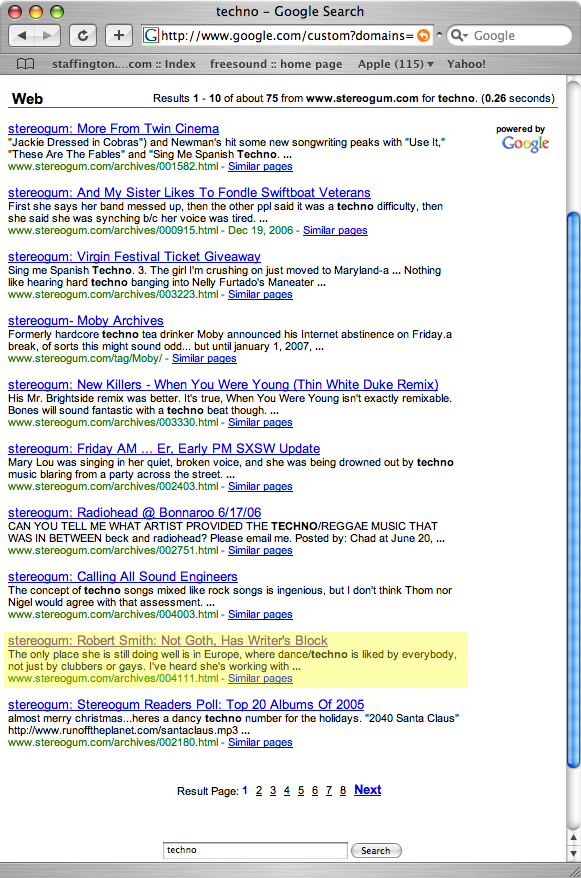Cracked out

How rad is this site?
« November 2006 | Main | January 2007 »

How rad is this site?
Not the real ILX, but it's nice to see that I Love Music is back, in limited, abridged, temporary, hesitant, etc. form. Feels a bit like a rambunctious kid wading back into the waters of the Social after a particularly hostile parentally mandated time-out; even the tone of discourse feels odd, stilted. But whatever, for those of you with nothing to do but bite yr nails over ye olde holidaye slowdowne, there's one more link for the clicking.
Bemused by today's predictably indie-riffic Stereogum Gummy Awards (to which I was alerted, as I am so many things these days, by the snarktastic Idolator), I decided to try a little experiment. Perhaps predictably, of the top 10 references to "techno" on Stereogum:
• two concern the New Pornographers' "Sing Me Spanish Techno"
• two are at least tangentially related to Radiohead
• one is shorthand for "technical"
• one describes moby
• and one is a noise complaint.
My favorite, however, is number nine, highlighted below.

Carl Wilson weighs in at the Slate critics' roundtable with a pretty fair assessment of what the critics missed this year--metal, noise, breakcore, non-trendy global musics and "new European dance sounds," but uses dubstep (somewhat misappelled as "hyperdub") as the lone synecdoche for said new European dance sounds, which is odd, since the UK makes a rather shaky synechdoche for Europe. (May I suggest some Continental techno?)
But I certainly can't argue with Wilson's claim (echoing Ann Powers) that "the main absence in the disembodied-music age is the body. What we overlook are real human beings in real places. And not just at shows, but in locally specific scenes and communities"; that would certainly explain why American critics don't "get" techno, since you can't really grok the stuff til a body feels a downbeat comin' through the rye of a thousand other bodies. (Indie rock, in contrast, I think you *can* "get" to a certain extent, without physical presence; or I should say, any music that slots itself into an indie rock MODEL--aesthetically, performatively, ideologically--can be lived *as* "live" culture within a downloading culture, substitutionally, by slotting a giving new act in the space occupied by known experience. (If you've been to an indie rock show, downloading, say, CSS or even Lady Sov won't require an entirely new set of values to understand the music and anticipate the live experience.) MySpace and MP3 blogs are essentially the yindie version of baseball cards--you internalize the first-order experience (the game, the players) by participating on this second-order level. But techno, given its inherent focus on physicality, sensuality, collective experience, etc.--dare I say, not to sound to rockist, immediacy--just doesn't work as well in an internet context. Not when the internet is the PRIMARY context, anyway. You do have to be there.)
And lord knows that most American critics aren't traveling much, whether it's due to shrinking editorial budgets (true, I'm sure) or the widespread cultural myopia that leads Americans, especially New Yorkers (no matter how liberal and allegedly cosmopolitan), to assume that anything not happening in their own front yard simply ain't worth covering. Since 2001, that's been the driving assumption behind most American music coverage, and look where it's gotten us.
Most years I couldn't give two hoots about the end-of-year hullabaloo, but this year, for whatever reason, I find myself strangely interested. (They make good memory jogs, if nothing else.) Maybe I'm just re-socializing myself after too much time spent sitting on the sidelines.
In any case, it was an honor to get to pen the the top-slot blurb for Pitchfork's Top 50 Albums list this year (as well as the #49 blurb—not a bad wingspan!): the Knife wins by a creepy country mile! I figured they'd place high, but number one? Dang. (I'm not half as surprised as most of the contributors to Stereogum's comments section, clearly. Warning: if you have an aversion to indie-dork snobbery, you probably want to skip clicking on that link. Then again, if your blood pressure is dangerously low, it might actually be good for you.)
I also weigh in on a few individual songs on Pitchfork's Top 100 Tracks list, where I couldn't have been more excited (or surprised) to see Radio Slave's "Deer in the Headlights" remix crack the top 100. (That song went criminally neglected this year, but I imagine we'll start hearing more of it once people hear it mixed into Jesse Rose's Body Language Vol. 3 in early 2007.)
I'm working on a proper year-end roundup; watch this space for it soon. In the meantime, check the always-reliable Tape for a killer and dizzyingly comprehensive Top 100 list, and Slate's traditional wrap-up (which I need to re-read… feeling too blurry after a redeye back from Santiago last night) for a more pop perspective. Personal to Caramanica and Rosen: Jon, you ask "Forget the genres you overlooked individually—what are we missing as a whole, and why?" Well, that's easy: the very elektronische Tanzmusik Jody mentions in his inaugural post. But you knew I'd say that! The why is the bigger, more interesting question, of course. I've got some ideas—not terribly original ones, granted—but I'd be interested to hear what you guys think. Electronic music may not be ubiquitous in the States, but given the blogosphere, it's hardly invisible either (especially with resources like Pitchfork admirably stepping up coverage in 2006); given the popular response to things like the Knife, it's also not as universally maligned as its more paranoid defenders (as I can sometimes be) often allege. So why does it lag in assessments like Slate's? What's the needed nudge?

For those interested, post-mortems from Hitchens (who, yeah, is almost intolerable on Iraq, but at least he got it right with Pinochet, early and often) and Marc Cooper, whose Pinochet and Me: A Chilean Anti-Memoir is well worth a read for anyone interested in the United States' complicity in Pinochet's coup.
We didn't make it down to Plaza Italia until after nightfall; the cops had apparently already dispersed all who had gathered there, though the scent of tear gas lingered, debris littered intersections and the odd fire still burned on street corners. All night long, helicopters cruised overhead, strafing the neighborhood with searchlights. Today, the death mask adorns front pages; otherwise business feels very much as usual.
Heard the news while driving down la Ruta 5, returning to Santiago from a little town called Tongoy, about five hours up the coast; when my girlfriend got the call on her mobile, coincidentally or no, we were listening to a Ricardo Villalobos DJ set. Perhaps inconsequential, but I couldn't help but feel some sort of providential Chilean-ness to the moment. The rest of the drive we listened to the radio nonstop, heard voices pro, voices contra (mostly, it must be said, contra). At the gas station, a television over the counter was broadcasting scenes from the dictator's life. Entering the city, at the very first stretch of high-rise buildings, a hand-painted banner celebrated, "Ya se cagó el dictador!" Here in the neighborhood of Providencia, not far from the military hospital where his supporters mourned—mostly women, said a news report—you can hear helicopters overhead, but mostly the streets are quiet. Two officers sit atop their steeds at an intersection; a car screams by waving red Communist flags. Plaza Italia is reportedly the scene of a massive anti-dictadura demonstration, all chants and champagne. El Mercurio, meanwhile—a notoriously pro-Pinochet newspaper, financed before and after the coup by the CIA—has yet to update its website. Almost seven hours later, they lead with workaday stories about the economy. La Tercera is far more timely, with a blog-style update recounting details of the demonstrations.
On my stereo: Bob Dylan, "Masters of War," inspired by this incredible article by Greil Marcus. Not an exact match, but the closing stanza certainly seems appropriate.
What good timing: I arrive in Chile, and eMusic publishes my column "The Sound of Exiled Chile" (catchy title, that), a brief introduction to eMusic catalog holdings from Ricardo Villalobos, Luciano, Dandy Jack, Señor Coconut, Sieg Über Die Sonne and Chica and the Folder. As an added bonus, there's a bit on a fantastic Violetta Parra album available on the site, a highly recommended collection of acoustic folksongs featuring only Parra's guitar and her absolutely heavenly voice. I didn't find room for them in the column, but two more recommended albums on eMusic are Quilapayun and Hector Duvachelle's Chile: The Siege of Santa Maria de Iquique, "A People's Cantata of the Chilean Nitrate Mines," and Chile: Songs for the Resistance, a collection of leftist folksongs made all the more relevant with Pinochet's heart attack this week. Both were released on Paredon, a leftist label active between 1970 and 1985, now a part of the Smithsonian. (For a free sample, check Paredon's streaming radio program, Songs of Protest: The 1970s, available on the Smithsonian/Paredon page linked just above.)